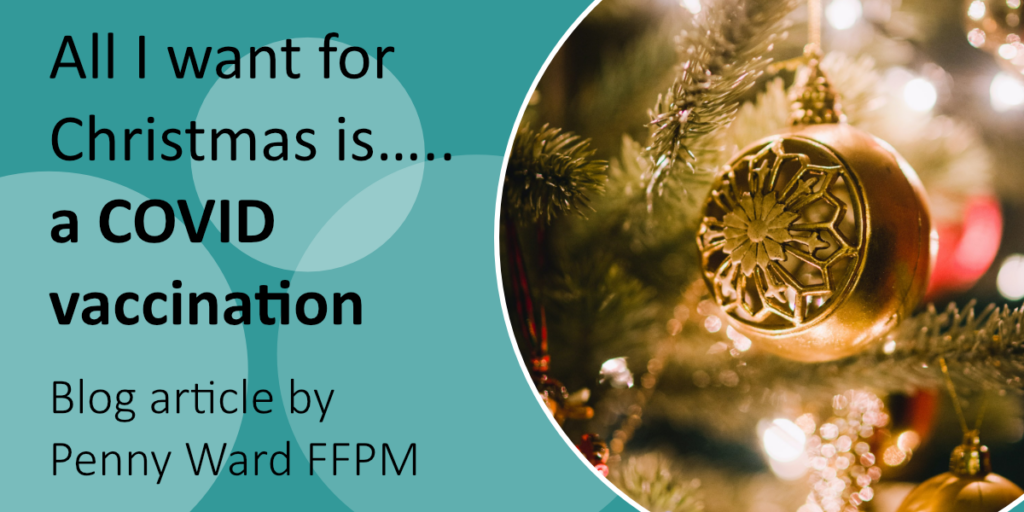All I want for Christmas is…..a COVID vaccination
Posted on: Wednesday 2 December 2020
Author: Penny Ward FFPM
After what seems like a long wait, we now know that vaccination can be used to prevent COVID-19 disease in 90% (or more) of vaccinees completing the course. One of these vaccines (perhaps more) may also reduce asymptomatic infection, with potential therefore for prevention of spread. So, now that the science has been proven, what happens next?

First…Make a ‘dossier’
First, companies concerned need to collate all the data from their research into a ‘dossier’ and submit this for independent review to the regulatory authorities in multiple countries. If the companies have followed good practice, this information will have been compiled in real time into the common technical document (CTD) format used by regulators across the world. In parallel, the raw manufacturing data – the information that provides reassurance that manufacturing is at the quality expected – will be ready to send. The first batches of vaccine to be distributed will already be on the production line or in cold (or frozen) storage ready for release as soon as the go-ahead is given.
Next…. Review the data
The regulators will need to keep a balance between the urgent need to have a vaccine available and the absolute requirement to ensure that the vaccine released for use has an acceptable benefit risk balance. In the USA, the Food and Drug Administration (FDA) get all the raw data from the preclinical and clinical studies and from the manufacturing runs, so their job is not only to read the summaries and reports provided by the companies but also to analyse the raw data and confirm the assessments made. In the UK, the regulator – the Medicines and Healthcare products Regulatory Agency (MHRA) – does not get the raw information, but must still read the summaries and check that the detailed reports provided reflect assessments made in the dossier. The MHRA is one of the most experienced – and efficient – agencies in the world, capable of completing this within weeks of dossier receipt. In addition, they have been a step ahead this year after starting a ‘rolling review’ of data on ongoing vaccine trials submitted in real time while research was underway. Only once the process is completed and the summary of product characteristics compiled can decisions on how to use the vaccine to its best advantage be made.
Define vaccination aims and priorities….
The decisions about whom to vaccinate first (given that the available number of doses will be limited initially) lies with the Joint Committee on Vaccination and Immunisation (JCVI); these experienced public health experts have currently presumed that the vaccines will prevent serious disease, hospitalization and death but might not prevent infection. Unsurprisingly, they have focused on first administration to those at highest risk from the disease e.g. residents of care homes and healthcare workers. They will then move down the risk ramp towards fit, younger people in stages as and when more doses are available.
Next ….vaccinate 12 million people…..twice
The population of over 65s in the UK is almost 12 million people. Can we do this – yes we can – we do it every year for the flu vaccine, but the flu vaccine is a single shot and uptake is often lower than target. For this disease all eligible people really do need to sign up and complete the two-dose vaccine course. Possible recipients need to be assured that the benefit to them will outweigh the risks of vaccine related side effects. Fortunately, side effects reported so far are minor – pain at the injection site and a mild flu like illness which can be readily managed with paracetamol/ibuprofen. Information will need to be shared widely to help people trust the vaccine and have any questions they have promptly answered.
Can we do it – yes we can, but to do this rapidly we will need to extend the number of people available to administer the vaccine and train them on the vaccine characteristics, so they can advise recipients and answer questions. There will also be a need for adequate storage and distribution networks (easier for refrigerated vaccines than frozen). Lastly, enough available clinics need to be set up in easy to reach localities convenient for people’s homes.
Continued monitoring
What do we still need to know? – how long protection lasts, will vaccination result in virus ‘escape’ mutations which limit vaccine effectiveness over time, if there may be rare but more serious side effects on widescale use.
We will only know the answers to these questions by continuing follow up in the clinical trials and by everyone being aware of and quickly reporting any unusual effects after vaccination. We will need to continue surveillance for infection and illness in the community with regular genotyping of the vaccine target spike protein to find and track such mutations so the vaccine can be updated as needed. This is done for influenza every year so the basis for surveillance is in place and will be helped by continued use of the extended testing systems now in place.
Can we eradicate the disease?
If the vaccine prevents infection as well as illness this could be achieved, but to do that we will need to vaccinate a high proportion of people in every country in the world, keeping abreast of any immune escape variants, to ensure that infection is continuously suppressed. Despite our best efforts, some individuals will not respond to vaccination, including people needing treatment for cancer or immune-suppressant treatment for inflammatory diseases such as rheumatoid arthritis or lupus, or after a transplant. These individuals remain at risk of infection with potential to spread that infection on to others. We will need additional approaches to help these people e.g. with passive immunity provided by anti COVID antibody therapies, or with antiviral drugs. So, lastly we must….
Continue to develop therapeutics to address additional needs.

